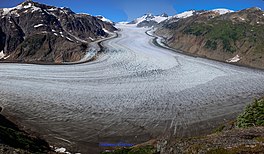Salmon Glacier
This article needs additional citations for verification. (February 2015) |
| Salmon Glacier | |
|---|---|
 View of the Salmon Glacier from the viewpoint. Mount Bayard to left, Mount White-Fraser partially visible to right. | |
| Type | Valley glacier |
| Location | Boundary Ranges British Columbia |
| Coordinates | 56°07′N 130°04′W / 56.117°N 130.067°W[1] |
The Salmon Glacier is a
natural hazard. Summit Lake is located at the northern end of the glacier and every year around mid-July the lake breaks an ice-dam and then flows under the Salmon Glacier into the Salmon River. This causes the river to rise approximately 4–5 ft (1.2–1.5 m) for several days.[citation needed
]
The glacier can be accessed by road from Hyder, Alaska, from early July to late September.
The glacier's name was officially adopted January 20, 1955, by the Geographical Names Board of Canada.[1]
Climate
Based on the
marine west coast climate zone of western North America.[2] Most weather fronts originate in the Pacific Ocean, and travel east toward the Coast Mountains where they are forced upward by the range (Orographic lift
), causing them to drop their moisture in the form of rain or snowfall. As a result, the Coast Mountains experience high precipitation, especially during the winter months in the form of snowfall. Temperatures can drop below −20 °C (−4 °F) with wind chill factors below −30 °C (−22 °F).
See also
References
- ^ a b "Salmon Glacier". Geographical Names Data Base. Natural Resources Canada. Retrieved 2019-12-05.
- S2CID 9654551.
External links
- "Salmon Glacier". BC Geographical Names.
- Google Map photo of the Salmon Glacier
- Flickr: Salmon Glacier and Mt. Bayard
- Weather: Salmon Glacier
- YouTube: Mt. Bayard seen from road
Further reading
Wikimedia Commons has media related to Salmon Glacier.
- Haumann, Dieter, 1960, Photogrammetric and glaciological studies of Salmon Glacier: Arctic, v. 13, no. 2, p. 74–100
- Clark, K.C., and Holdsworth, G., 2002, U.S. Geological Survey Professional Paper 1386-J: Satellite Image Atlas of Glaciers of the World -- North America, p. 291-299

